https://www.youtube.com/watch?v=pO8TUuSv7HA
The Best Way to Cook Steak - The Reverse Sear _ Kenji's Cooking Show

Hey , Verus Kenji , uh I'm gonna show you how to reverse sear a big steak .
So the reverse here and I know people are going to start talking about this in the comments .
But the reverse here is a process that I developed when I was working at Cook's Illustrated around 2006 or so .
And when I say I developed , I just want to be clear when I say I developed , I'm not claiming to be the first person to ever do this because I'm pretty , it's pretty clear that I'm not .
But at the time , the reverse se was not really a known technique in , in the , in the period since we published that in 2007 , some people have brought it to my attention , mainly meat head over at amazing ribs dot com where you can find a full history of the reverse tier .
Um It was brought to my attention that a guy named Chris Finney was for , I think it was the barbecue team is called Iron Pig Barbecue , but he was , he was writing on barbecue forums about doing the reverse here .
A couple of years before I published it and Cooks Illustrated .
Um So I'm confident in saying that .

Um , well , I came up with the process independently .
Um I , I sort of modeled it after sous vide because we were cooking sous vide in restaurants a lot those days .
Um And that , until we publish it and Cooks Illustrated , it was definitely not like a mainstream process , certainly not what it is .
Now , we didn't call it originally call it the reverse sear .
Um We just called it , I don't remember what we called it .
We called it a new way to pan to pan your steaks .
Um Anyhow , the process , regardless of the origins of it , um The process is um based on the , the idea behind so vide , which is where um rather than the traditional method of cooking steak where you would um in a restaurant , what you would do is you would sear it over a very high heat , either on a grill or under a broiler or in a pan and then you would slide it into an oven to finish cooking .
That method works really well if your goal is to cook steaks fast , which is usually your goal in a restaurant .
But what it does is it ends up giving you a sort of gradient , a temperature gradient where the very center is might be medium rare or whatever temperature you want it .
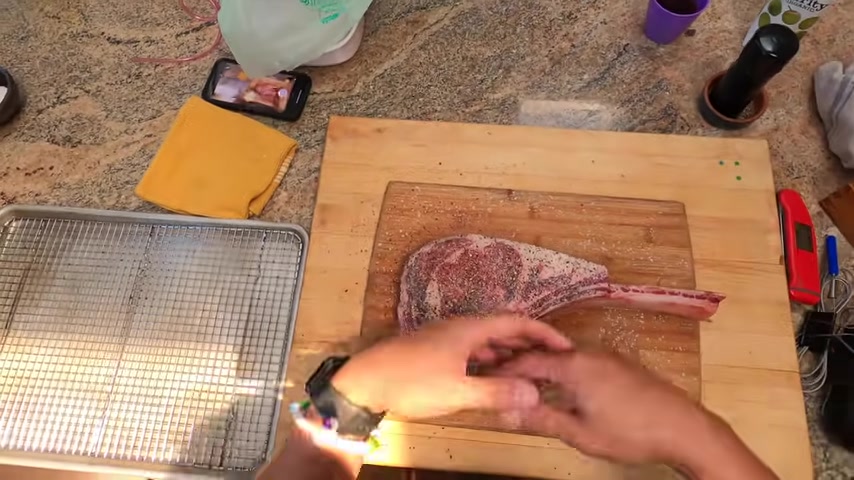
And then as you get closer to the edges , it gets more and more well done .
So you get this kind of bull's eye pattern .
And what the reverse here does is you reverse the order of those things .
So you start it in a low temperature oven .
In this case , we're going to go with a 250 degree oven .
You start with a low temperature oven and then you let it come up to temp and then you take it out and sear it at the end .
And what that gives you , what you'll see at the end is that it gives you a very perfectly even doneness from all the way from edge to center .
So what I've got here is a thick , this works especially well with thicke , by the way , it's not really worth it for anything thinner than like an inch and a half .
This is about 2.5 inch thick .
Um , two and a quarter to 2.5 inch thick , uh tomahawk .
So that's a rib steak .
Um , comes from the loin uh with a good chunk of Spinalis here , which is my favorite part of a steak .
Uh And uh yeah , so we're gonna , we got it seasoned salt and pepper .
That's it .
Plenty of salt and pepper .
Um We're going to put it on this rack on a sheet tray .
I'm gonna a temperature probe into it .
Ok ?
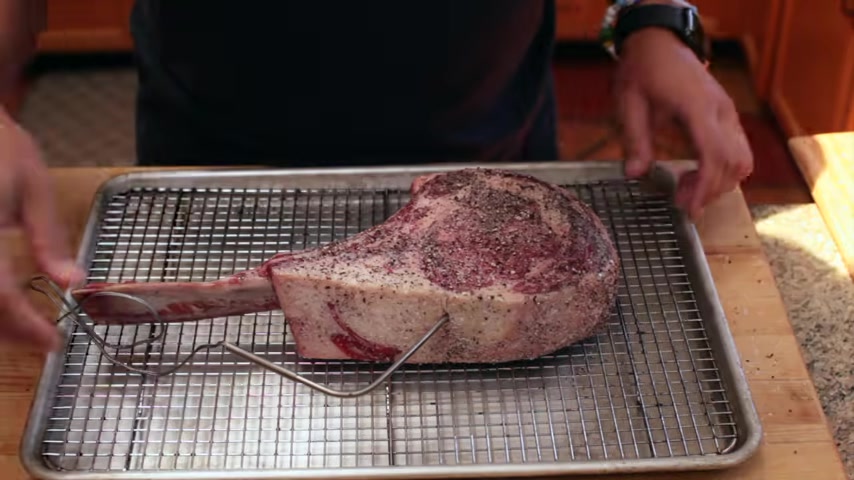
You want to go on the side and get it towards the center as close to the center as you can .
I have this temperature probes alarm set at 125 F .
And then I'm going to slide it right into a 250 degree oven and it's going to stay in there until it gets to 125 F , which is going to be a medium rare .
It should take a steak that thick is probably going to take about two hours at this temperature .
So this is a technique you use when you got some time on your hands .
In fact , you could also add some time to the steak if you want , if you , if you have too much time on your hands .
All right .
So I will see you back here once this goes off , which should be in just about an hour and 45 minutes .
So , not quite two hours .
Actually , we're at 123.8 degrees .
So getting pretty close to 125 you could let it go all the way to 125 .
Anywhere between 121 125 .
Even up to around 130 is going to be in that medium rare range .
All right .
So now that we're getting close to done , we got to get ready for the searing portion .
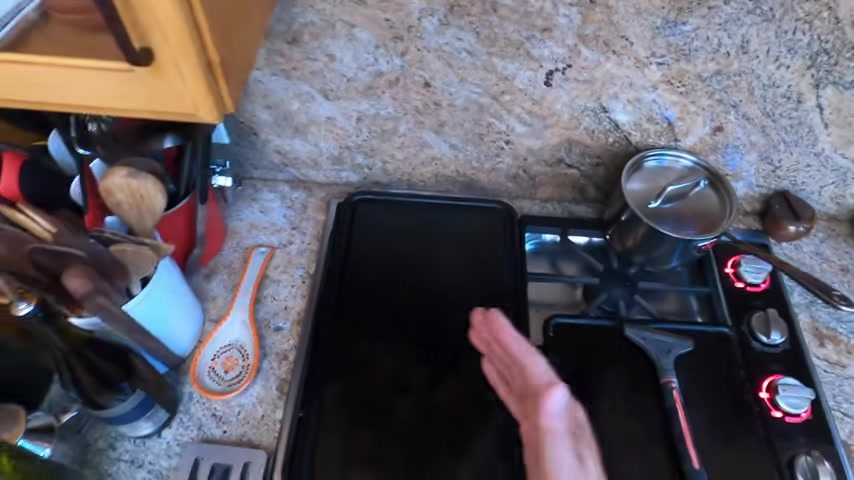
So , what I've got is this baking steel , all , I'm only using this big one because that's a Tomahawk steak and it's not going to fit inside a normal pan .
So with a Tomahawk steak like that , you would either do it on something like this , like a flat griddle with a channel or you can finish it on your grill .
Of course , with a smaller steak that fits in a pan , you can do this on a pan .
So cast iron .
But what you want to do is you want to really , really preheat it till it's ripping hot .
So like smoking hot , OK ?
Because the idea is that now you're going to spend as little time as possible , actually searing the meat .
You want to build up a crust and that's about it .
So the longer it takes , the longer it takes over high heat like that , the longer it takes on a burner , the more sort of that gradient inside is going to get built up .
So your goal is really just to sear it as fast as possible .
That's the whole point of sort of separating the cooking into two different steps .
All right .
So I'm gonna take this probe out now .

Um And I'm gonna double check my temperature .
You also want to double check your temperature with an actual um non , like not a leave in probe because the leaven probe can actually transmit heat down its length .
So it'll give you a sort of false positive high readings .
Um You always want to double check with a hand held thermometer .
All right , we're good .
We're at 100 2600 and 27 .
So we're , we're gonna be right around that sort of mid rare to medium range .
Um , which is for a fatty cut , like a rib eye .
That's the temperature .
I like to go .
I like to go a little bit hotter than rare or a little hotter than even sort of the low end of medium rare .
Um , because you really want to get it warm enough or at least I want to get it warm enough that the fat's going to start to a little bit .
All right .
So we are smoking hot , which means we're about ready to start searing looking good .
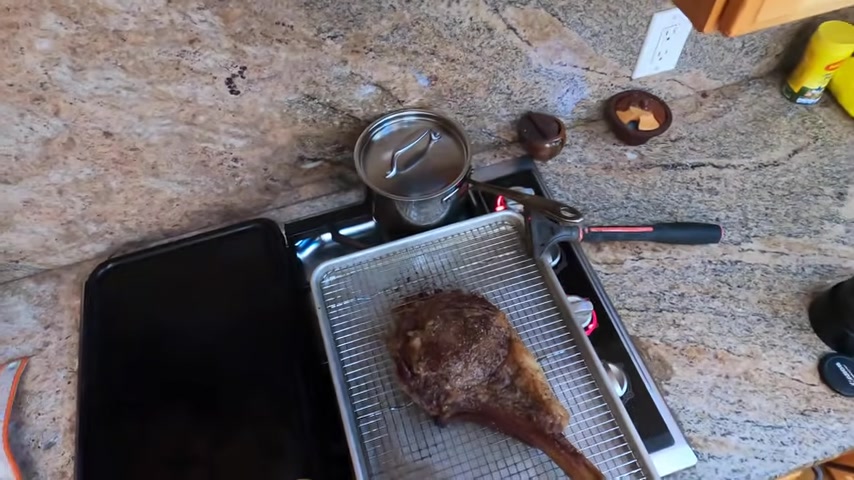
So , one of the , one of the reasons you , um , you start in a low oven like that is because , um , what happens is if you have a , a raw steak , there's a lot of surface moisture .
Um , and it takes a lot of energy to evaporate that surface moisture .
About , it takes about 50 times , 50 times , five more times , five times more energy to evaporate a drop of water than it does to take that water all the way from zero degrees to 100 degrees Celsius .
So , the , the , the thing that takes the most energy when you're searing steak is surface moisture , evaporating surface moisture .
So by starting in a low oven , you end up drying off all that moisture .
So what you see here is not actually like steak juices , what you're seeing there is fat and that's gonna help the steak , uh , sear better .
All right .
So , just a little bit of oil .
This is rice brand oil .
You could use any kind of neutral , high temp oil , rice brand canola , something like that grape seed .
And I'm gonna weigh this guy down with my chef's presses .
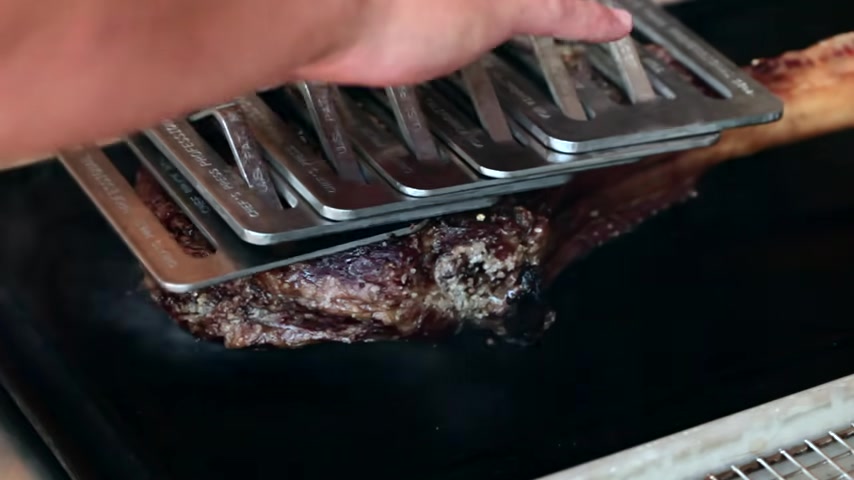
Oh , by the way , Bruce Hill , the inventor of the chef's press who's based here in California , based in the Bay Area .
When we did that charity sale a couple of weeks back through the end of July , he said it was the , the highest selling month ever for the product .
And he donated somewhere between five and $6000 to Black Lives Matter .
And um , yeah , so thank you all for buying the chefs presses .
During that time .
There's still , you can still get them at chef dot com .
I don't take any money from them .
I never take money from for sponsorships .
Anything that I recommend I'm doing of my own will no money ever exchanged for recommendations .
So I use these all the time .
They're really great for things like this .
You see how big the steak is and I can shingle them to really get a nice even sear across the whole surface .
All right , let's see .
Uh let's see how we're doing here .
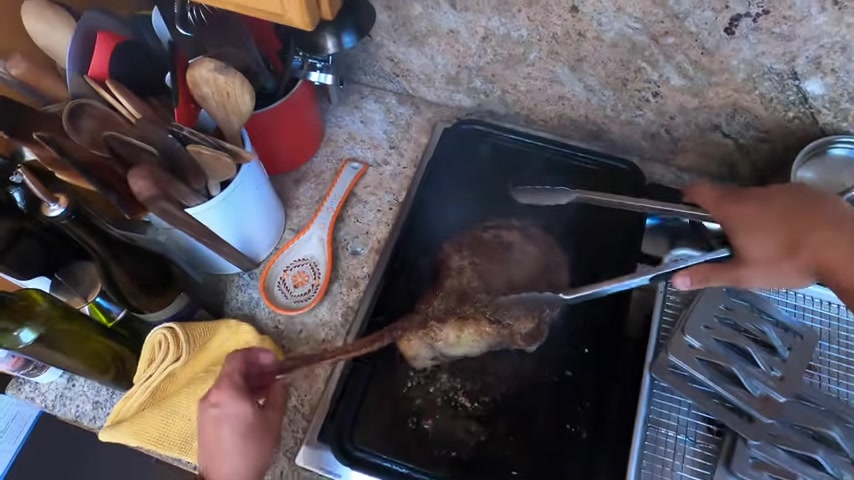
Doing good thing .
You go just a little bit longer on that first side .
Oh , so if you were cooking sous vide , you would do a very similar thing .
You would cook the , cook the steak to whatever temperature you want to serve it at , you want whatever internal temperature you want .
So it could be 121 125 130 .
Then you'd in a restaurant setting , what you would do is you would leave the steak in the water bath for service .
And then when someone orders the steak , you take it out and sear it .
That way you can have perfectly cooked steak reliably , um , and be able to serve it quite fast .
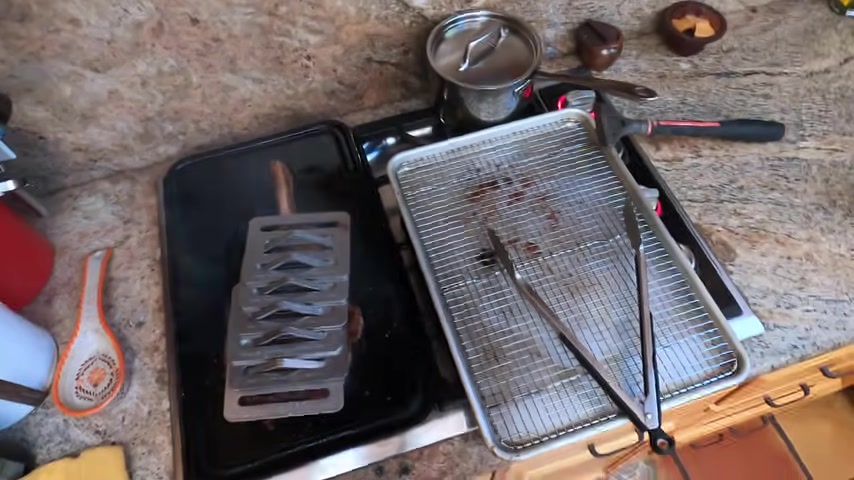
You know , the , the other nice thing about the reverse sear compared to more traditional cooking methods is that that window of perfect doneness is much wider .
So when you're cooking in a traditional way with a very hot oven or a very hot pan , it's very quickly going to rise from say 125 up to 135 .
It could take , it could take a couple of minutes , maybe even less if you're cooking hot enough .
So it's a very small window .
You have to get it precisely done the way you want it .
What the reverse sear does is that it gives you more like probably 10 or 15 or even 20 minutes before it starts to overcook in the oven .
So you have a , you have a much higher likelihood that you're going to get a steak cooked exactly the way you want it when you do a reverse sear .
Oh Yeah .
Look at that .
Look at that brownie .
All right .
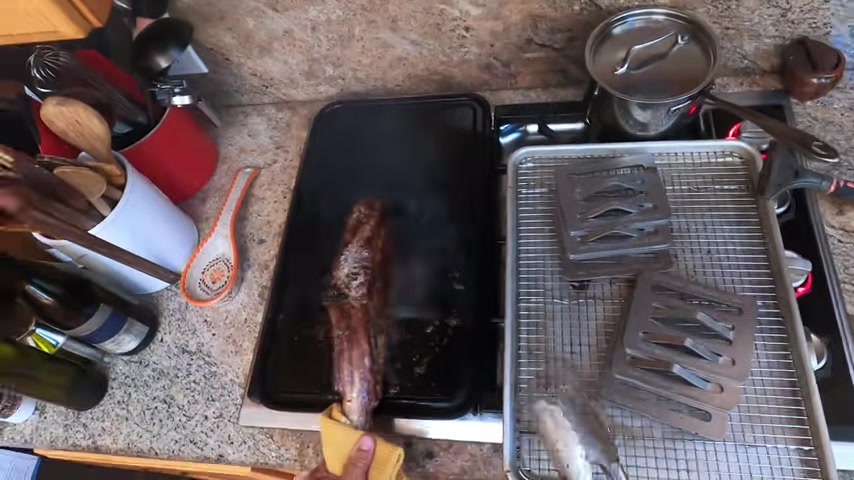
Last , last , but not least we're gonna make sure that we see this side .
Yeah .
I'm just gripping it with a towel like this .
I actually prefer reverse fear even though the technique originally , I developed it to be able to sort of mimic sous vide at home .
I actually prefer the technique over sous vide mainly because you get that dry surface when you're reverse searing .
So you can actually sear the meat better than you can a sous vide steak .
And moreover , it renders the fat a little bit better than the sous vide technique does .
So you end up with , I think just a better , better finished , better finished product overall .
All right .
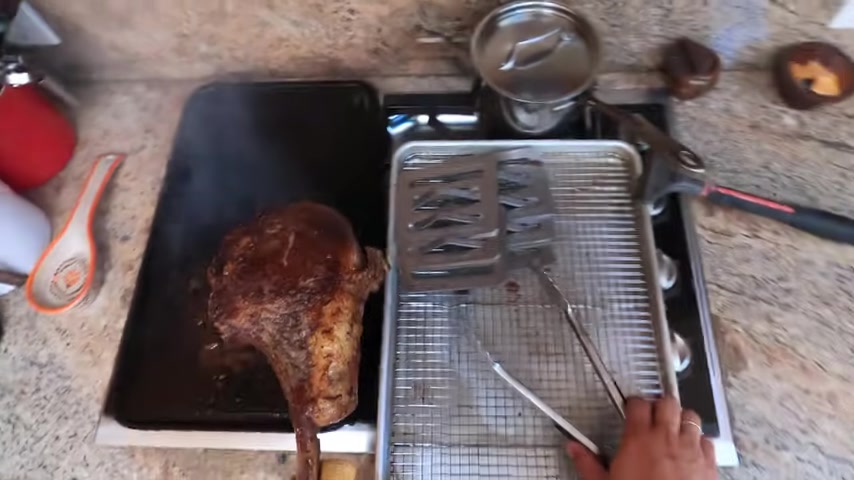
And we are , we're done .
All right , we get a board the service on .
Should we cut into it ?
Shall we see how we did ?
I'm just going to split her kind of open right now .
Just so we can just so I can show you that how that temperature gradient works inside .
There you go .

Look at that beautiful and see that temperature gradient or the lack of temperature gradient .
That's really uh and that is what the SUV with the reverse here gets you .
This is this , this steak is big enough to serve at least four people for dinner .
I'd say for hungry people even look at that .
Hm .
Perfect .
Perfect shabu .
Come on .
Well , they are in for a treat today .
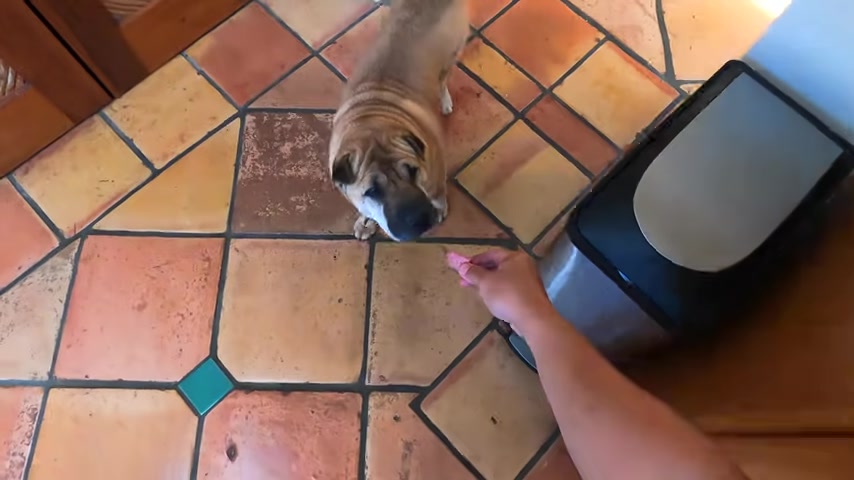
Should you go ?
And here you go , buddy .
Right .
Everyone that is the reverse here .
Thank you all for watching guys gals and non binary pals and I will see you next time .
Bye bye .
Are you looking for a way to reach a wider audience and get more views on your videos?
Our innovative video to text transcribing service can help you do just that.
We provide accurate transcriptions of your videos along with visual content that will help you attract new viewers and keep them engaged. Plus, our data analytics and ad campaign tools can help you monetize your content and maximize your revenue.
Let's partner up and take your video content to the next level!
Contact us today to learn more.